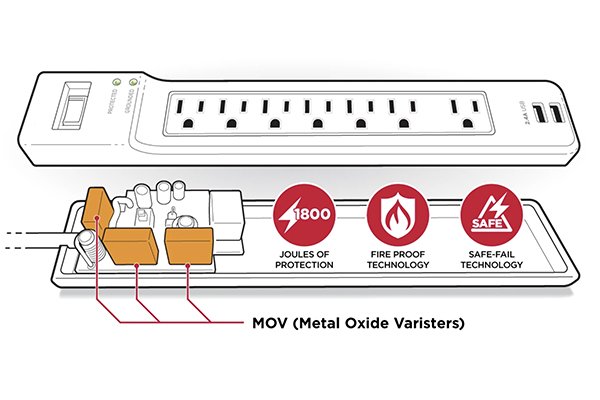What Does Joule Rating Mean in Surge Protectors?

When shopping for surge protector1s, one term you’ll often see is “joule rating2.” Understanding this number is essential to choosing the right device for safeguarding your electronics.
A surge protector1’s joule rating2 indicates how much energy it can absorb before failing. The higher the rating, the more protection your devices receive.
Understanding Joules: The Basics of Surge Protection

A joule is a unit of energy. In surge protector1s, it measures the total amount of excess electricity the device can absorb from voltage spikes before it can no longer provide protection.
For example, a surge protector1 with a 1,000-joule rating2 can absorb more total energy over time than one rated at 300 joules, offering longer-lasting defense against power surges.
Surges often come from lightning strikes, utility grid switching, or sudden changes in power demand. Without a surge protector1, these spikes can damage sensitive electronics instantly.
Why Joule Rating Matters for Your Devices’ Safety

The joule rating2 determines how much cumulative energy the surge protector1 can handle before its internal components—usually metal oxide varistors (MOVs)3—wear out.
- Low joule rating2 (200–600): Suitable for small electronics like lamps or basic chargers.
- Medium joule rating2 (600–1,000): Ideal for home office setups or TVs.
- High joule rating2 (1,000+): Recommended for gaming PCs, home theater systems, and expensive electronics.
Once a surge protector1’s joule capacity is depleted, it no longer protects devices, even if it still supplies power.
How Much Joule Rating Do You Really Need?

The right joule rating2 depends on both device value and local surge risk.
| Device Type | Recommended Joules |
|---|---|
| Phone chargers, lamps | 200–600 |
| Desktop PCs, monitors | 800–1,200 |
| Home theater, gaming setups | 1,500–2,000+ |
| High-risk surge areas (storm-prone regions) | 2,000+ |
If you’re in a region with frequent storms or unreliable power, investing in a high joule rating4g](https://www.eaton.com/us/en-us/products/backup-power-ups-surge-it-power-distribution/surge-protection/how-many-joules-does-my-surge-protector-need-.html)[^2] surge protector1 is wise.
Joule Rating vs. Other Specs: What to Prioritize

While joule rating2 is important, it’s not the only factor to consider:
- Clamping Voltage: Lower is better—it’s the voltage level at which the surge protector1 activates.
- Response Time: Faster response means better protection.
- Number of Outlets: Choose enough for current and future needs.
- UL Certification: Ensures the product meets safety standards.
Prioritize a combination of a high joule rating4g](https://www.eaton.com/us/en-us/products/backup-power-ups-surge-it-power-distribution/surge-protection/how-many-joules-does-my-surge-protector-need-.html)[^2], low clamping voltage5, and reliable certifications for optimal protection.
Conclusion
A surge protector1’s joule rating2 is a key indicator of how well—and for how long—it can shield your electronics from damaging power surges. Higher ratings mean more durable protection, but you should also consider other specifications like clamping voltage5 and certification. By understanding joules and matching the rating to your needs, you can protect your devices more effectively and extend their lifespan.
-
Explore how surge protectors function to shield your devices from damaging power surges. ↩ ↩ ↩ ↩ ↩ ↩ ↩ ↩ ↩ ↩
-
Understanding joule rating helps you choose the right surge protector to safeguard your electronics effectively. ↩ ↩ ↩ ↩ ↩ ↩ ↩ ↩ ↩ ↩
-
Learn about MOVs, the key components in surge protectors that absorb excess energy. ↩
-
Understand the advantages of high joule rating surge protectors for valuable electronics. ↩ ↩
-
Discover why lower clamping voltage is crucial for better surge protection. ↩ ↩






